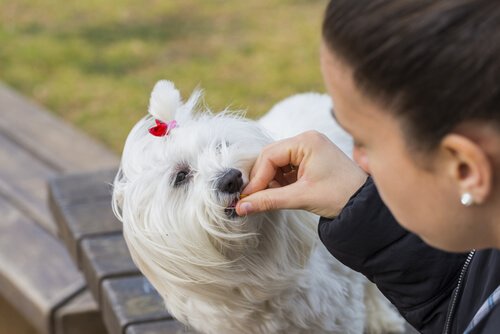What is Veterinary Phytomedicine?


Written and verified by the lawyer Francisco María García
For decades, mankind has used plants to treat diseases, a technique known as phytomedicine. This practice specifically applies to veterinary phytomedicine for treating animal pathologies.
Herbs are known for their countless health benefits. During the primitive age, man discovered that they had the power to heal their wounds. They also found out that they had qualities for treating common diseases.
Even animals instinctively use plants to cause certain effects on their bodies. A good example is when dogs eating grass in order to purge themselves.
Although it’s still not very common, veterinary medicine is opening up to the practice of phytomedicine, especially for animals whose way of nourishing themselves is through eating natural foods.
Experts in the animal world use veterinary phytomedicine to treat diseases. In some cases, they use it to treat simple wounds. However, they have also started to use it for more complex pathologies, to replace medicine.
It’s impossible to overlook the fact that specialists in this area define veterinary phytomedicine as a natural medicine that is good for everything.
Origin of veterinary phytomedicine
In Oriental culture, curative herbs are commonly used, unlike Western culture, where medical treatments are more readily available.

Mankind has studied plants for several years due to their benefits, that’s why some principles of Western medicine come from herbs. Such is the case of salicylic acid (from the willow tree), atropine and scopolamine (from the Belladonna), and silymarin (obtained from the carduus marianus).
Research has discovered another key factor: entire plants offer different curative properties. A plant’s benefits are not only concentrated in its leaves or branches, but the sometimes roots as well.
Therefore, homeopathic medicine often uses the entire plant. For example, the gel from Aloe Vera leaves are used to heal wounds, and the root of the popular ‘ cat’s claw ‘ helps treat swelling.
Note that veterinary phytomedicine is a relatively new practice. People have begun to work hard to gain awareness of the benefits that plants have on the bodies of animals.
What are the advantages of veterinary phytomedicine?
1. It’s less invasive for the body.
Using veterinary phytomedicine doesn’t expose the animal’s body to many chemical components, which in turn decreases the toxicity. In addition, side effects caused by drugs or treatments are minimized, so there are no risks of experiencing them.
2. There are several ways to apply it.
You can give herbs to animals in several ways: infusions, syrups and macerations are the most common. A specialist will choose the most appropriate method depending on the animal and how willing it is. Other presentations include inhalations or tinctures.
3. Dose management.
Veterinary Phytomedicine allows you to dose the medicine according to an animal’s traits, and also check the dosage as it progresses in its treatment.
Another benefit is that, because they are herbs, they can be combined to achieve better effects. Combining them doesn’t cause an overdose or intoxication. However, that’s not true with all medications. It’s important to point out that in many cases, combining medicines can cause irreversible side effects.
4. Low cost and accessible.
Veterinary Phytomedicine is more cost-effective and you can access it immediately, without having to go through any medical protocol. However, don’t forget that it’s important to know each herb’s properties and benefits in order to apply it correctly.

Likewise, you should be knowledgeable about what conditions of the plant are the most effective. Some herbs are more helpful if dehydrated beforehand, while others are better fresh.
There are different plants in every region with common medical benefits, so knowing the similarities between species does help, in order to have options for medicinal treatments.
Specialists recommend to feed animals natural food in order for veterinary phytomedicine to have a greater effect. In other words, replace processed food with homemade food.
In conclusion, we should clarify that the benefits of practicing both types of medicine together favor an animal’s physical and emotional well-being. Also, you’ll notice its effects immediately.
For decades, mankind has used plants to treat diseases, a technique known as phytomedicine. This practice specifically applies to veterinary phytomedicine for treating animal pathologies.
Herbs are known for their countless health benefits. During the primitive age, man discovered that they had the power to heal their wounds. They also found out that they had qualities for treating common diseases.
Even animals instinctively use plants to cause certain effects on their bodies. A good example is when dogs eating grass in order to purge themselves.
Although it’s still not very common, veterinary medicine is opening up to the practice of phytomedicine, especially for animals whose way of nourishing themselves is through eating natural foods.
Experts in the animal world use veterinary phytomedicine to treat diseases. In some cases, they use it to treat simple wounds. However, they have also started to use it for more complex pathologies, to replace medicine.
It’s impossible to overlook the fact that specialists in this area define veterinary phytomedicine as a natural medicine that is good for everything.
Origin of veterinary phytomedicine
In Oriental culture, curative herbs are commonly used, unlike Western culture, where medical treatments are more readily available.

Mankind has studied plants for several years due to their benefits, that’s why some principles of Western medicine come from herbs. Such is the case of salicylic acid (from the willow tree), atropine and scopolamine (from the Belladonna), and silymarin (obtained from the carduus marianus).
Research has discovered another key factor: entire plants offer different curative properties. A plant’s benefits are not only concentrated in its leaves or branches, but the sometimes roots as well.
Therefore, homeopathic medicine often uses the entire plant. For example, the gel from Aloe Vera leaves are used to heal wounds, and the root of the popular ‘ cat’s claw ‘ helps treat swelling.
Note that veterinary phytomedicine is a relatively new practice. People have begun to work hard to gain awareness of the benefits that plants have on the bodies of animals.
What are the advantages of veterinary phytomedicine?
1. It’s less invasive for the body.
Using veterinary phytomedicine doesn’t expose the animal’s body to many chemical components, which in turn decreases the toxicity. In addition, side effects caused by drugs or treatments are minimized, so there are no risks of experiencing them.
2. There are several ways to apply it.
You can give herbs to animals in several ways: infusions, syrups and macerations are the most common. A specialist will choose the most appropriate method depending on the animal and how willing it is. Other presentations include inhalations or tinctures.
3. Dose management.
Veterinary Phytomedicine allows you to dose the medicine according to an animal’s traits, and also check the dosage as it progresses in its treatment.
Another benefit is that, because they are herbs, they can be combined to achieve better effects. Combining them doesn’t cause an overdose or intoxication. However, that’s not true with all medications. It’s important to point out that in many cases, combining medicines can cause irreversible side effects.
4. Low cost and accessible.
Veterinary Phytomedicine is more cost-effective and you can access it immediately, without having to go through any medical protocol. However, don’t forget that it’s important to know each herb’s properties and benefits in order to apply it correctly.

Likewise, you should be knowledgeable about what conditions of the plant are the most effective. Some herbs are more helpful if dehydrated beforehand, while others are better fresh.
There are different plants in every region with common medical benefits, so knowing the similarities between species does help, in order to have options for medicinal treatments.
Specialists recommend to feed animals natural food in order for veterinary phytomedicine to have a greater effect. In other words, replace processed food with homemade food.
In conclusion, we should clarify that the benefits of practicing both types of medicine together favor an animal’s physical and emotional well-being. Also, you’ll notice its effects immediately.
This text is provided for informational purposes only and does not replace consultation with a professional. If in doubt, consult your specialist.








